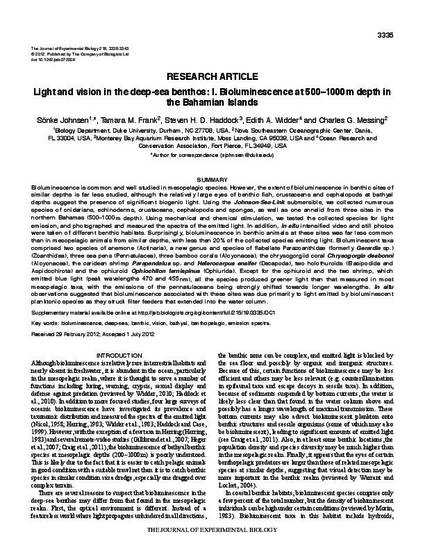
- Bioluminescence,
- Deep-sea,
- Benthic,
- Vision,
- Bathyal,
- Benthopelagic,
- Emission spectra
Bioluminescence is common and well studied in mesopelagic species. However, the extent of bioluminescence in benthic sites of similar depths is far less studied, although the relatively large eyes of benthic fish, crustaceans and cephalopods at bathyal depths suggest the presence of significant biogenic light. Using the Johnson-Sea-Link submersible, we collected numerous species of cnidarians, echinoderms, crustaceans, cephalopods and sponges, as well as one annelid from three sites in the northern Bahamas (500–1000 m depth). Using mechanical and chemical stimulation, we tested the collected species for light emission, and photographed and measured the spectra of the emitted light. In addition, in situ intensified video and still photos were taken of different benthic habitats. Surprisingly, bioluminescence in benthic animals at these sites was far less common than in mesopelagic animals from similar depths, with less than 20% of the collected species emitting light. Bioluminescent taxa comprised two species of anemone (Actinaria), a new genus and species of flabellate Parazoanthidae (formerly Gerardia sp.) (Zoanthidea), three sea pens (Pennatulacea), three bamboo corals (Alcyonacea), the chrysogorgiid coral Chrysogorgia desbonni (Alcyonacea), the caridean shrimp Parapandalus sp. and Heterocarpus ensifer (Decapoda), two holothuroids (Elasipodida and Aspidochirota) and the ophiuroid Ophiochiton ternispinus (Ophiurida). Except for the ophiuroid and the two shrimp, which emitted blue light (peak wavelengths 470 and 455 nm), all the species produced greener light than that measured in most mesopelagic taxa, with the emissions of the pennatulaceans being strongly shifted towards longer wavelengths. In situ observations suggested that bioluminescence associated with these sites was due primarily to light emitted by bioluminescent planktonic species as they struck filter feeders that extended into the water column.

©2012. Published by The Company of Biologists Ltd